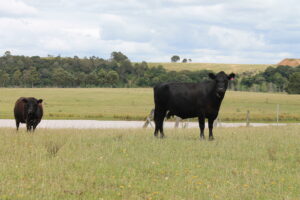If you’ve been into a supermarket lately you have probably noticed more specials on beef and lamb, creeping into the red meat cabinet. If you look closely you’ll still find premium cuts at the $40/kg plus price point, but Australian Bureau of Statistics (ABS) data tells us meat has followed saleyards lower in September, albeit slowly.
Those with their finger on the pulse, or perhaps more those with plenty of debt, will have heard the news regarding the release of Consumer Price Index (CPI) data last week. The headline number of the annual CPI change of 5.37% is not great news for anyone with debt, increasing speculation of an interest rate rise on Melbourne Cup Day.
Digging deeper into the data we can find the numbers for changes in retail meat prices. Figure 1 shows that beef and lamb continued to ease in price at the retail level in the September quarter. Beef was down 1.22% for the quarter, taking the annual fall to 3.37%. September 2022 was the peak of retail beef prices.
For lamb, the price fall was heavier, with retail prices down 4.67% for the quarter, and 5.72% for the year. The lamb peak came a quarter earlier than beef, with lamb now 7% off the June 2022 quarter, so significantly cheaper than the highest prices.
Figure 2 looks at the change in retail beef prices, and the change in the National Heavy Steer Indicator at the saleyard level, both on an annual basis. It’s not surprising to see saleyard prices being much more volatile than retail, both when prices are increasing and decreasing.
If we look at five-years ago, cattle prices were similar to now, but retail prices were 35% lower. There is likely some more room for prices to move lower for retail prices or cattle prices to rise.
On the lamb front, Figure 3 shows the change in lamb meat at the retail level, and the ESTLI, on an annual basis. The year-on-year fall in lamb at saleyards by far outstrips the retail decline. While supermarkets generally pay above saleyard rates for lambs over the hooks, there is again, further room for lamb prices to decline at the retail level.
What does it mean?
For beef and lamb, domestic consumption remains the largest single market for Australian product. While it doesn’t tend to drive prices, it does offer a stabilising influence, and any increase in consumption is welcome.
With chicken and pork prices continuing to gain ground on red meat (Figure 1) we can hope the decline in domestic consumption of red meat halts or turns around, adding support for livestock values.
Have any questions or comments?
Key Points
- ABS data shows beef and lamb prices falling again at retail level in the September quarter.
- Retail price falls have been small compared to saleyard price declines.
- Domestic consumption is important for supporting livestock prices.
Click on figure to expand
Click on figure to expand
Click on figure to expand
Data sources: MLA, ABS, Mecardo















